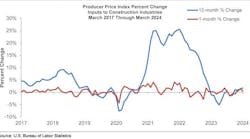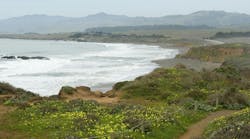Many years ago, I read The Last Days of the Late, Great State of California, a novel by Curt Gentry. Starting with the real history of California, the 1968 book went on to describe a fictional, devastating earthquake – the so-called “Big One” – that causes the portion of the state west of the San Andreas Fault to fall into the ocean, causing ripple effects across the country and around the world.
Having grown up in Southern California, with its ubiquitous earthquakes, I found the book to be both fascinating and terrifying.
Fast forward to 2024 and, although it’s unlikely that a large chunk of California is going to disappear into the Pacific anytime soon, there is no doubt that parts of the coastline are already falling into the ocean. California has always be prone to landslides after heavy rainfall and significant seismic events, and stories of multi-million-dollar homes lost to mudslides after heavy rains are legendary.
These landslides can also cause significant damage to infrastructure, like roads and powerlines, hindering rescue and recovery efforts. The torrential rainfall from the recent atmospheric rivers have caused widespread damage, with homes lost, hundreds of neighborhoods flooded, and even major roads closed, including portions of the Pacific Coast Highway and the 105 Freeway.
Los Angeles, which like the rest of the state was in a drought two years ago, just experienced its wettest February in 26 years, according to the National Weather Service. The city received over 12.5 in. of rain, more than three times its monthly average. According to Dr. Daniel Swain, a climate scientist at UCLA’s Institute of the Environment and Sustainability, these atmospheric rivers can hold as much as 15 times more water than the Mississippi River, and he estimates that they can deliver some 5% to 15% more rain because of anthropogenic climate change.
Of course, I live in South Florida now, and I’m constantly reminded that climate change results in more frequent and intense weather events, such as our risk from Atlantic Ocean hurricanes. Some, 2,500 miles west, climate change is altering the face of the California coastline due to the landslides and sea level rise, and climate scientists warn that the risk is increasing.
But now some coastal residents think their state government is exacerbating the situation as they face what they perceive as a threat from a proposed law that would remove residential areas near the beach from the oversight of the California Coastal Commission.
Created to enforce the 1976 California Coastal Act, the Commission has the authority to overturn or modify development permits issued by local governments. The pending legislation would exempt apartment development from the Commission’s authority, raising the fear that it could lead to uncontrolled development in an area already at risk from the weather.
Finding solutions to rising global temperatures is obviously a critical goal for scientists. In the meantime, elected officials need to carefully manage policies that affect sensitive environmental locations. That’s one area where politics doesn’t have to clash with science.
##########
A regular contributor to HPAC Engineering and a member of its editorial advisory board, the author is a principal at Sustainable Performance Solutions LLC, a south Florida-based engineering firm focusing on energy and sustainability. He can be reached at [email protected].









